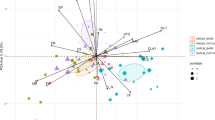Summary
The spatial arrangement of tiller replacement was assessed on grazed and ungrazed tussocks of Agropyron desertorum (Fisch. ex Link) Schult. for three annual cycles. Frequency distributions of the number of replacement tillers per single progenitor were also determined. Tiller replacement was usually greater on the perimeter of tussocks than within the core, with or without grazing. Replacement was inversely related to grazing intensity, both on the perimeter and within the core of tussocks. Heights of replacement tillers on the perimeter or within the core seldom differed. Furthermore, grazing seldom affected the number of replacement tillers per progenitor. Greater tillering on the perimeter than within the core indicates that the tussocks were expanding. Apparently, grazing neither enhances tussock expansion and subsequent disintegration, nor does it necessarily lead to patches of tillers (multiple tillering per progenitor) within tussocks of A. desertorum.
Similar content being viewed by others
References
Balph DF, Malechek JC (1985) Cattle trampling of crested wheatgrass under short-duration grazing. J Range Manage 38:226–227
Bleak AT, Keller W (1973) Differential tolerance of some aridrange wheatgrasses to snow mold. J Range Manage 26:434–435
Caldwell MM, Richards JH (1986) Competing root systems: morphology and models of absorption. In: Givnish TJ (ed) On the economy of plant form and function. Cambridge University Press, Cambridge, pp 251–273
Caldwell MM, Dean TJ, Nowak RS, Dzurec RS, Richards JH (1983) Bunchgrass architecture, light interception and water use: assessment by fiber optic point quadrats and gas exchange. Oecologia (Berlin) 59:178–184
Clements FE (1907) Plant physiology and ecology. Henry Holt and Company. New York
Cook RE (1979) Asexual reproduction: a further consideration. Am Nat 113:769–772
Deregibus VA, Sanchez RA, Casal JJ, Trlica MJ (1985) Tillering responses to enrichment of red light beneath the canopy in humid natural grasslands. J Appl Ecol 22:199–206
Fienberg SE (1980) The analysis of cross-classified categorical data. MIT Press, Cambridge, Massachusetts
Fowler NL (1986) Density-dependent population regulation in a Texas grassland. Ecology 67:545–554
Gurevitch J (1986) Competition and the local distribution of the grass Stipa neomexicana. Ecology 67:46–57
Harberd DJ (1962) Some observations on natural clones in Festuca ovina. New Phytol 61:85–100
Harper JL (1980) Plant demography and ecological theory. Oikos 35:244–253
Harper JL (1985) Modules, branches and the capture of resources. In: Jackson JBC, Buss LW, Cook RE (eds) Population biology and evolution of clonal organisms. Yale University Press, New Haven
Harper JL, Bell AD (1979) The population dynamics of growth form in organisms with modular construction. In: Anderson RM, Turner BD, Taylor LR (eds) Population dynamics. Blackwell Scientific Publishing, Oxford, pp 29–52
Hartnett DC, Bazzaz FA (1983) Physiological integration among intraclonal ramets in Solidago canadensis. Ecology 64:779–788
Mack RN, Thompson JN (1982) Evolution in steppe with few large, hooved mammals. Am Nat 119:757–773
Mueller RJ, Richards JH (1986) Morphological analysis of tillering in Agropyron spicatum and Agropyron desertorum. Ann Bot 57:911–921
Olson BE (1986) Tiller dynamics of Agropyron desertorum in response to grazing and resource manipulation. PhD dissertation, Utah State University, Logan, Utah
Olson BE, Richards JH (1988) Annual replacement of the tillers of A. desertorum following grazing. Oecologia 76:1–6
Pavlik BM (1983) Nutrient and productivity relations of the dune grasses Ammophila arenaria and Elymus mollis. III. Spatial aspects of clonal expansion with reference to rhizome growth and the dispersal of buds. Bull Torrey Bot Club 110:271–279
Pechanec JF, Pickford GD, Stewart G (1937) Effects of the 1934 drought on native vegetation of the Snake River plains, Idaho. Ecology 18:490–505
Salzman AG (1985) Habitat selection in a clonal plant. Science 228:603–604
Watt AS (1938) Studies in the ecology of Breckland. III. The origin and development of the Festuca-Agrostideum on eroded sand. J Ecol 26:1–37
Author information
Authors and Affiliations
Rights and permissions
About this article
Cite this article
Olson, B.E., Richards, J.H. Spatial arrangement of tiller replacement in Agropyron desertorum following grazing. Oecologia 76, 7–10 (1988). https://doi.org/10.1007/BF00379593
Received:
Issue Date:
DOI: https://doi.org/10.1007/BF00379593




